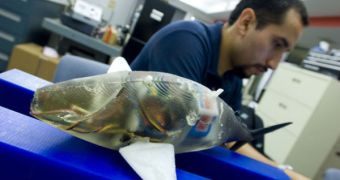Collecting live information from inside fish colonies and marine ecosystems was never an easy task for naturalists and documentary reporters. The human factor is always tainting the results of studies, and it therefore needs to be eliminated. This is precisely what a new type of robotic fish will do, in addition to providing scientists with up-to-date pollution readings. The small robots will also investigate submarine structures, such as sunken ships and coral reefs, and will do so without disturbing any other marine species, LiveScience reports.
The new fish were produced by a team of mechanical engineers from the Massachusetts Institute of Technology (MIT), including recent PhD recipient Pablo Valdivia Y Alvarado and colleague Kamal Youcef-Toumi. Their model, which is about a foot long, is able to go in places where autonomous diving robots cannot. The technology used to make the fish is not new, having been demonstrated as far back as 1994. However, unlike the old, four-foot-long robot (which had 2,843 parts and six motors), the new one has only a single motor, and ten individual components, strategically placed inside the robotic model.
Rather than having a propeller, the new construct moves ahead by generating a wave-like motion in its midsection, which is precisely how real fish go about moving around. The wave is amplified along the fish's undulating, sleek body, and is turned into propelling power. The robot can now swim with a speed of one body length per second, which is far faster than that of previous generations. However, considering that actual fish can reach ten body lengths per second, the team still has a long way to go before it creates an accurate replica of an ocean-dweller.
“The fish were a proof of concept application, but we are hoping to apply this idea to other forms of locomotion, so the methodology will be useful for mobile robotics research – land, air and underwater – as well,” Valdivia Y Alvarado explains. The team's idea appears in a recent issue of the journal Dynamic Systems Measurements and Control (ASME), and will be further detailed in Valdivia Y Alvarado's doctoral thesis, to be held soon. The Singapore-MIT Alliance and Schlumberger Ltd. were the main financial supporters of the innovative research.

 14 DAY TRIAL //
14 DAY TRIAL //